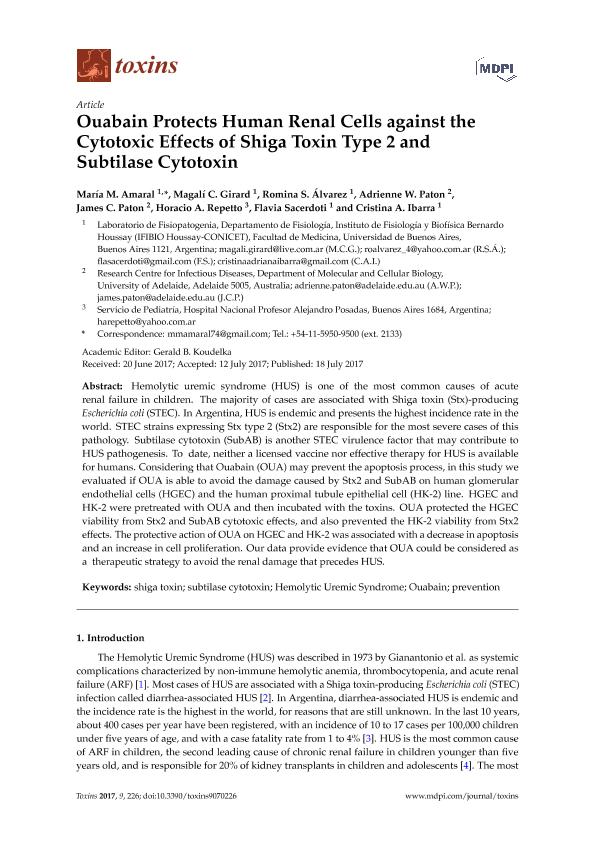Artículo
Ouabain protects human renal cells against the cytotoxic effects of Shiga toxin type 2 and subtilase cytotoxin
Amaral, María Marta ; Girard, Magalí Celeste; Alvarez, Romina Soledad
; Girard, Magalí Celeste; Alvarez, Romina Soledad ; Paton, Adrienne W.; Paton, James C.; Repetto, Horacio Antonio; Sacerdoti, Flavia
; Paton, Adrienne W.; Paton, James C.; Repetto, Horacio Antonio; Sacerdoti, Flavia ; Ibarra, Cristina Adriana
; Ibarra, Cristina Adriana
 ; Girard, Magalí Celeste; Alvarez, Romina Soledad
; Girard, Magalí Celeste; Alvarez, Romina Soledad ; Paton, Adrienne W.; Paton, James C.; Repetto, Horacio Antonio; Sacerdoti, Flavia
; Paton, Adrienne W.; Paton, James C.; Repetto, Horacio Antonio; Sacerdoti, Flavia ; Ibarra, Cristina Adriana
; Ibarra, Cristina Adriana
Fecha de publicación:
18/07/2017
Editorial:
MDPI AG
Revista:
Toxins
ISSN:
2072-6651
Idioma:
Inglés
Tipo de recurso:
Artículo publicado
Clasificación temática:
Resumen
Hemolytic uremic syndrome (HUS) is one of the most common causes of acute renal failure in children. The majority of cases are associated with Shiga toxin (Stx)-producing Escherichia coli (STEC). In Argentina, HUS is endemic and presents the highest incidence rate in the world. STEC strains expressing Stx type 2 (Stx2) are responsible for the most severe cases of this pathology. Subtilase cytotoxin (SubAB) is another STEC virulence factor that may contribute to HUS pathogenesis. To date, neither a licensed vaccine nor effective therapy for HUS is available for humans. Considering that Ouabain (OUA) may prevent the apoptosis process, in this study we evaluated if OUA is able to avoid the damage caused by Stx2 and SubAB on human glomerular endothelial cells (HGEC) and the human proximal tubule epithelial cell (HK-2) line. HGEC and HK-2 were pretreated with OUA and then incubated with the toxins. OUA protected the HGEC viability from Stx2 and SubAB cytotoxic effects, and also prevented the HK-2 viability from Stx2 effects. The protective action of OUA on HGEC and HK-2 was associated with a decrease in apoptosis and an increase in cell proliferation. Our data provide evidence that OUA could be considered as a therapeutic strategy to avoid the renal damage that precedes HUS.
Palabras clave:
Hemolytic Uremic Syndrome
,
Ouabain
,
Prevention
,
Shiga Toxin
,
Subtilase Cytotoxin
Archivos asociados
Licencia
Identificadores
Colecciones
Articulos(IFIBIO HOUSSAY)
Articulos de INSTITUTO DE FISIOLOGIA Y BIOFISICA BERNARDO HOUSSAY
Articulos de INSTITUTO DE FISIOLOGIA Y BIOFISICA BERNARDO HOUSSAY
Citación
Amaral, María Marta; Girard, Magalí Celeste; Alvarez, Romina Soledad; Paton, Adrienne W.; Paton, James C.; et al.; Ouabain protects human renal cells against the cytotoxic effects of Shiga toxin type 2 and subtilase cytotoxin; MDPI AG; Toxins; 9; 7; 18-7-2017; 1-14
Compartir
Altmétricas



